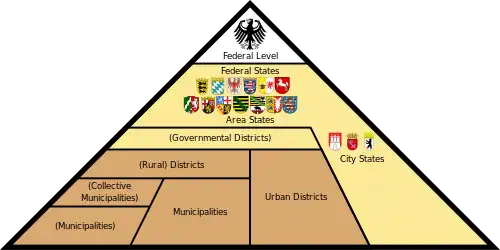Municipalities of Germany
Municipalities[1] (German: Gemeinden, singular Gemeinde) are the lowest level of official territorial division in Germany. This can be the second, third, fourth or fifth level of territorial division, depending on the status of the municipality and the Land (federal state) it is part of. The city-states Berlin and Hamburg are second-level divisions. A Gemeinde is one level lower in those states which also include Regierungsbezirke (singular: Regierungsbezirk) as an intermediate territorial division (Baden-Württemberg, Bavaria, Hesse and North Rhine-Westphalia). The Gemeinde is one level higher if it is not part of a Gemeindeverband ("municipal association").[1]
| Municipalities of Germany Deutsche Gemeinden (German) | |
|---|---|
| Category | Municipality |
| Location | Germany |
| Found in | District (Kreis) Regierungsbezirk |
| Populations | 11 (Gröde) - 3,600,000 (Berlin) |

| This article is part of a series on the |
| Politics of Germany |
|---|
 |
The highest degree of autonomy may be found in the Gemeinden which are not part of a Kreis ("district").[1] These Gemeinden are referred to as Kreisfreie Städte or Stadtkreise, often translated as "urban district". In some states they retained a higher measure of autonomy than the other municipalities of the Kreis (e.g. Große Kreisstadt). Municipalities titled Stadt (town or city) are urban municipalities while those titled Gemeinde are classified as rural municipalities.
With more than 3,600,000 inhabitants, the most populous municipality of Germany is the city of Berlin; and the least populous is Gröde in Schleswig-Holstein.
Municipalities per federal state
Status as of December 2018.
| Federal state | Municipalities[2] | Municipalities with town status[2] | Municipalities that are urban districts[2] | Average no. of inhabitants[2][3] | Average area (km2)[2] | Lists (Cities, Towns, Municipalities) |
|---|---|---|---|---|---|---|
| Baden-Württemberg | 1,101 | 313 | 9 | 10,012 | 32.5 | C, T, M |
| Bavaria | 2,056 | 317 | 25 | 6,321 | 34.3 | C, T, M |
| Berlin | 1 | 1 | 1 | 3,613,000 | 891.0 | Berlin |
| Brandenburg | 417 | 113 | 4 | 6,005 | 71.1 | C, T, M |
| Bremen | 2 | 2 | 2 | 340,500 | 209.5 | Bremen, Bremerhaven |
| Hamburg | 1 | 1 | 1 | 1,831,000 | 755.2 | Hamburg |
| Hesse | 422 | 191 | 5 | 14,759 | 49.9 | C, T, M |
| Lower Saxony | 939 | 159 | 8 | 8,426 | 50.5 | C, T, M |
| Mecklenburg-Vorpommern | 726 | 84 | 2 | 2,148 | 31.1 | C, T, M |
| North Rhine-Westphalia | 396 | 271 | 22 | 45,232 | 86.1 | C, T, M |
| Rhineland-Palatinate | 2,301 | 129 | 12 | 1,768 | 8.6 | C, T, M |
| Saarland | 52 | 17 | 0 | 19,115 | 49.4 | C, T, M |
| Saxony | 419 | 169 | 3 | 9,694 | 43.8 | C, T, M |
| Saxony-Anhalt | 218 | 104 | 3 | 10,197 | 93.8 | C, T, M |
| Schleswig-Holstein | 1,106 | 63 | 4 | 2,613 | 14.3 | C, T, M |
| Thuringia | 631 | 124 | 6 | 2,620 | 19.7 | C, T, M |
| Germany | 11,014 | 2,058 | 107 | 7,517 | 32.5 | C, T, M |
Municipal reforms
The number of municipalities of Germany has decreased strongly over the years: in 1968 there were 24,282 municipalities in West Germany, and in 1980 there were 8,409.[4] The same trend occurred in the New states of Germany after the German reunification: from 7,612 municipalities in 1990[5] to 2,627 at the end of 2018.[2] While in some cases growing cities absorbed neighbouring municipalities, most of these mergers were driven by a need to increase the efficiency and reduce costs of administration.[4] At the same time, many districts and also urban districts were merged into larger districts.
Types of municipalities
There are several types of municipalities in Germany, with different levels of autonomy. Each federal state has its own administrative laws, and its own local government structure. The main types of municipalities are:
- city state (German: Stadtstaat): Berlin and Hamburg are both municipalities and federal states
- urban district (Kreisfreie Stadt, in Baden-Württemberg: Stadtkreis): a municipality that is not part of a district, and hence fulfills the responsibilities of both a municipality and a district. As of 2018, there are 107 urban districts (including Berlin and Hamburg)[2]
- town (Stadt): a municipality with the right to call itself "Stadt". The title "Stadt" does not imply any duties or rights anymore. Many towns received town privileges in the Middle Ages, others were elevated to town status more recently because they reached a certain size, e.g. more than 10,000 inhabitants
- municipality forming part of a municipal association (Amtsangehörige Gemeinde, Verwaltungsgemeinschaftsangehörige Gemeinde, Mitgliedsgemeinde or Ortsgemeinde in Rhineland-Palatinate): a municipality with a mayor and a municipal council, but no other administrative institutions. Administrative duties are performed by the Gemeindeverband ("municipal association")[1]
- municipality not forming part of a municipal association (Amtsfreie Gemeinde, Einheitsgemeinde or Verbandsfreie Gemeinde in Rhineland-Palatinate): a municipality that fulfills all responsibilities of a municipality
Local elections
In all municipalities, the mayor and the members of the municipal council are appointed by local elections that take place on a regular basis. Elections for the municipal councils (Kommunalwahlen) take place every 4 years in Bremen, every 6 years in Bavaria and every 5 years in all other states.[6]
The office of mayor is full-time (hauptamtlich) in larger municipalities, and voluntary (ehrenamtlich) in smaller municipalities, for instance those that are part of a municipal association. Mayors are elected for a specific term, which is different in every state. Since mayoral elections also have to be held when a mayor resigns from office, these do not take place at the same time for all municipalities in a state. The terms for mayors are:[7]
- Baden-Württemberg: 8 years
- Bavaria, Hesse, Thuringia: 6 years
- Berlin, Hamburg: 5 years, indirect elections
- Brandenburg, Rhineland-Palatinate: 8 years for full-time mayors, 5 years for voluntary mayors
- Bremen: 4-6 years, indirect elections
- Lower Saxony, North Rhine-Westphalia: 5 years
- Mecklenburg-Vorpommern: 7-9 years for full-time mayors, 5 years for voluntary mayors
- Saarland: 10 years
- Saxony, Saxony-Anhalt: 7 years
- Schleswig-Holstein: 6-8 years for full-time mayors, 5 years for voluntary mayors
See also
References
- Country Compendium. A companion to the English Style Guide, European Commission, May 2021, pages 58–59.
- "Statistisches Jahrbuch 2019" (PDF). Statistisches Bundesamt. p. 29. Retrieved 8 July 2021.
- Populations as of December 31, 2017
- Guth, D.; Scheer, J. (November 2010). "Kommunale Gebietsreformem und Vergleichbarkeit von Gemeindestrukturdaten" (PDF). Raum und Mobilität - Arbeitspapiere des Fachgebiets Verkehrswesen und Verkehrsplanung. TU Dortmund. 20.
- "Gebietsreformen – politische Entscheidungen und Folgen für die Statistik" (PDF). BBSR-Berichte KOMPAKT. Bundesinstitut für Bau-, Stadt- und Raumforschung. 6. July 2010.
- Übersicht über die Wahlsysteme bei Kommunalwahlen, accessed 12 July 2021.
- Kost, A.; Wehling, H.-G. (2010). Kost, Andreas; Wehling, Hans-Georg (eds.). Kommunalpolitik in den deutschen Ländern: Eine Einführung (in German). Springer-Verlag. doi:10.1007/978-3-531-92034-4. ISBN 978-3-531-17007-7.